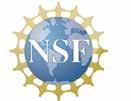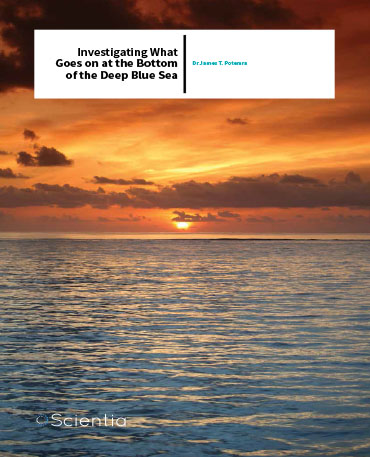Dr James T. Potemra – Investigating What Goes On At The Bottom Of The Deep Blue Sea
Probing the Mysteries of the Deep
What do you think of when you think of the ocean floor? Maybe you find yourself looking out of the viewport of the submarine Nautilus at Captain Nemo and his hard-hat divers, as they trudge slowly along the ocean landscape. Or perhaps you find yourself in the deep-sea mining vehicle Big John, roving the Pacific seafloor while Dirk Pitt sits at the controls singing Minnie the Mermaid. Wherever your mind wanders, it probably doesn’t wander much beyond the realm of fiction. What do we really know about the sea? Look at the news these days and you are much more likely to see reports of, say, the 2020 Mars Rover, the International Space Station or the latest meteor shower. You usually don’t hear much about the ocean or oceanography, except perhaps for an article here or there about a beached pod of dolphins or an advertisement for the next season of Shark Week. Although over 70% of the Earth is covered with water, it may appear that not much attention is paid to our oceans. But Dr Potemra and his colleagues do – and they have been for over a decade. Today, they use the ALOHA Cable Observatory, or ACO, to watch the seafloor over the Internet!
The ACO, which is funded by the National Science Foundation, comprises a suite of instruments, cumulatively about the size of a Volkswagen Beetle, on the sea floor north of Oahu, Hawaii. These instruments include a range of ocean-monitoring devices that measure pressure, temperature, salinity and currents, but also include a hydrophone, to measure sounds in the ocean, and cameras and lights. All of these instruments send data to shore via an undersea cable provided by AT&T, to be published ultimately on the World Wide Web for scientists and the public alike to see and use. The system is unique not only because it is the deepest such observatory in the world, but also because it provides a platform – including electrical power and Internet – at one of the most remote places on earth. Data from the ACO are wide-ranging, and scientists like Dr Potemra use these data to study things like marine mammal presence (from acoustics), seismic activity, deep ocean thermal variability and circulation, and much more. As one of the most under-sampled regions in the world, any new information coming from the ACO represents a significant advancement in our understanding of the ocean.
‘How the antifreeze glycoproteins, as well as other antifreeze proteins, evolved into functional antifreeze molecules is of much interest to evolutionary biologists’
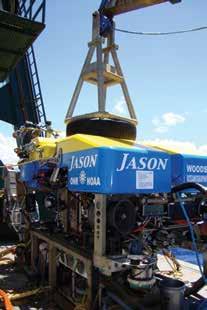
Almost 20 Years in the Making
Since it seems humans can more easily walk on the Moon than on the floor of the deepest ocean, collecting data on the world’s oceans has been tedious and frustrating. Historically, shipboard spatial surveys and maps of marine characteristics conducted by early oceanographers revealed some secrets of the seas. Think of Charles Darwin and the sailing ship HMS Beagle, cataloguing islands and wildlife in the Pacific Ocean. However, time series measurements were required to explore the variations of the ocean at a single location. Repeated shipboard observations at particular sites provided access to such variations, but the temporal sampling is limited by the duration capabilities of the ship and crew. In addition, the characteristics of the ocean at any particular spot may change between successive lowerings of instruments, since the ocean contains large amounts of energy varying at high frequencies. Such measurements were often only accurate for a short time.
To cope with the sampling problems – like having a ship and crew anchored in a particular spot for weeks at a time – engineers packaged sensors (e.g., temperature, pressure, acoustic, seismic) into pressure-resistant cases along with batteries and tape recorders. The sensors could be dropped and left and recovered later. While this strategy provided great insight into subsea conditions, the records were always limited by either battery capacity or data storage. Understanding the dynamic processes of the ocean and sea floor required long-time series to reliably quantify deep sea conditions. Oceanographers needed a paradigm shift in their methods of observing the ocean. Enter the Conference on the Scientific Uses of Submarine Cables, in Honolulu, in 1990. The discussion ensued: How can we use retired but still useful undersea cables from telecommunications companies to carry data from subsurface oceanographic sensors?
Hawaii Ocean Timeseries
The ACO is located at Station ALOHA, an ocean location 100 km north of Oahu, Hawaii, nominally a circle 12 km across. It is the study site of the Hawaii Ocean Timeseries (HOT) program. HOT is focused on studying processes that control the distributions and cycling of elements in the sea – with specific focus on carbon – in sufficient detail to provide predictive understanding on how global scale changes to ocean climate influence biogeochemical transformations. To achieve this broad objective, the programs sought understanding of the linkages between seasonal, interannual and long-term (multi-decadal) variability and trends in ocean physics, chemistry and biology. Processes underlying physical and biogeochemical temporal variability were also studied, as well as the role of physical forcing on carbon fluxes, including rates of biologically-mediated carbon transformations, air-sea CO2 exchange and carbon export.
HOT was started in late 1988 and relies primarily on traditional oceanographic protocols, such as quasi-monthly ship cruises to make the measurements. However, it attracted a multitude of related science projects because of its location and comprehensive scope. It is the combination of all these activities that makes Station ALOHA such a unique and attractive science study site. Subsequently, a surface mooring was placed near Station ALOHA to provide much needed atmospheric observations (e.g., wind speed and rainfall), the Woods Hole Oceanographic Institution/Hawaii Ocean Time-series Site (WHOTS) mooring.
Then, in 2002, a portion of the retired AT&T HAW-4 submarine fibre optic cable was donated to the University of Hawaii – actually, it was sold to the University for $1. HAW-4 had been one of several first generation fibre optic systems installed in 1988. It has 3 fibre pairs (one is spare), each of which is capable of transmitting at 295 Mb/s.
The cable originally ran from the Makaha Cable Station, Oahu, Hawaii to Point Arena Cable Station, California, a distance of 4260 km. In the 60 repeaters spaced every 70 km or so, the light signal was converted to an electrical signal, amplified, and changed back to light to continue on. In early 2007 the US Navy graciously cut the cable, moved the Hawaii end to Station ALOHA, about 100 km north of Oahu, and attached an initial set of sensors to the end of the cable. This provided continuous, real-time sound from the site to shore. The signal is then transmitted directly to waiting scientists like Dr Potemra and his colleagues at the UH campus. The piece that connects ACO to Oahu is 237 km long. The other segment that terminates in California is much longer, roughly 4000 km.
The perfect combination – and a drone!
In June 2011, a general purpose node was deployed on the site. This provided an interface into which instruments could be plugged and through which data and power could flow. Since then, two more cruises using deep diving remotely operated vehicles (ROV) – in other words, undersea robots – have gone to the ACO site to deploy additional sensors and instrumentation. The ACO site is on the sea floor approximately 5 km deep. The extreme pressures and its remote location make work here challenging, but the real-time monitoring coupled with the surface mooring and HOT program allow for unique, wide-ranging studies of the ocean and earth’s climate.
Physically, the ACO is made up of a set of different platforms, all resting on the seafloor and connected by cable. The undersea cable from the shore is terminated at the ACO ‘junction box’ (JBOX) that converts the telecommunication protocols to 100 Mb/s Ethernet. A hydrophone experiment model (HEM) and pressure sensor are mounted on the JBOX. Following the cable from the JBOX, the next platform is the main component of the ACO, the so-called OBS. Like the JBOX, the OBS has instruments mounted on its frame, including sensors for temperature/ salinity, ocean current and pressure. In addition, the OBS provides the outlets for additional components. These outlets, or ports, allow for additional sensors to get power and data links. At present there are two Basic Sensor Packages (BSP-1 and BSP-2), two video cameras, and several lights connected to the OBS. Despite the best of engineering, due to the extreme pressures and otherwise harsh environment, several of the instruments have failed, most notably the light system, so the available video footage is limited.
However, there are many other data streams coming from the ACO in real-time. These include total water column pressure, near bottom temperature, near bottom salinity, north/south and east/west current speeds from about 100 meters off the bottom to the near sea floor, ambient ocean sounds, turbidity, fluorescence (which is indicative of chlorophyll content). Archived data include several months of underwater video and additional hydrophone data.
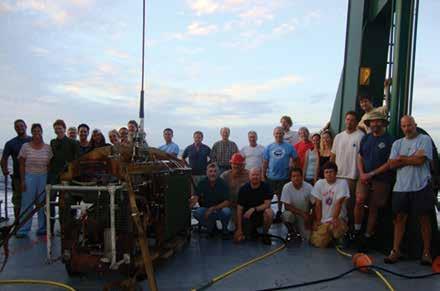
It’s all about meeting challenges
The ACO facility represents advances in many different areas. First, there is the challenge of working in the ocean environment, where salt and water can be extremely hard on electrical components. Special care needed to be taken in designing the instrument modules to prevent leaks and corrosion.
Second is the challenge presented working at great depths, where there is a complete absence of natural light and the pressures are extreme (almost 7000 psi). At 4728 m, this is currently the deepest operating cabled observatory with ‘plug and play’ capability. The ACO team was able to overcome these pressures with pressure tolerant housings and specially designed cables and connectors that allow instruments to plug into the ACO directly on the ocean floor using unmanned submersibles.
The third challenge involves the cyber-infrastructure aspect of real-time data systems. Since the site is so remote and a single cable is involved, bandwidth and Internet port management is critical. The ACO has been able to manage these and still provide real-time data, including video, that is streamed directly to the web. In fact, anyone with Internet access can view ACO data from the comfort of their own couch by logging into http://aco-ssds.soest.hawaii.edu/dataDisplay.php.
It is pretty clear that Dr Potemra and his colleagues have met these challenges. The ALOHA Cabled Observatory has succeeded and will continue to shed light on the science of the seafloor and the water column above for many years to come.
The Agenda – Now and for the Future
There are several on-going and future scientific studies using the ACO. The original concept was to demonstrate the ability to put in place a deep-sea observatory that was directly connected to a base on land so as to provide real-time access to the sensors and power to the instrumentation. That has been accomplished. On-going observations includes studies of deep-sea biology, abyssal circulation and mixing, and acoustic signatures of earthquakes, ships, marine mammals, wind waves and rain. Other proposals in progress deal with predatorscavenger community dynamics, benthic community response to changing climate and food supply, and a mooring system sampling the full water column on a rapid, sustained and adaptive basis to address the carbon cycle, water column dynamics and mixing, and bio-physical interactions.
So now the ACO is now actively seeking scientists to take advantage of the ACO platform for their studies. Some proposals have focused on monitoring the benthic community with a bottom ‘rover’ that would be powered by the ACO and would study the sediments around the site. NASA has the Mars Rover to dig up Barsoom; why can’t ACO have a rover to take samples on the ocean floor? It’s time that stories of the seas and oceans stop taking a backseat to news about space.
Meet the researcher
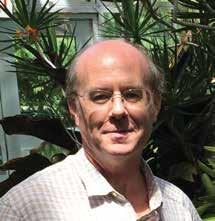
Dr James T. Potemra
Manager, Asia-Pacific Data-Research Center
International Pacific Research Center Hawaii Institute of Geophysics and Planetology
University of Hawaii
USA
Professor Gordon Taylor at the Stony Brook School of Marine and Atmospheric Sciences has been researching oxygen depleted marine habitats for more than 23 years. After receiving his PhD from University of Southern California, Los Angeles in 1983, he has held several positions with both the University of Hawaii and Stony Brook University, where he became a full professor in 2005. In 2014, he founded the NAno-Raman Molecular Imaging Laboratory at Stony Brook through a National Science Foundation grant. There, he continues his research through his research project on ‘Genetic and Metabolic Signatures of Marine Microorganisms in Oxygen Depleted and Varying Geochemical Seascapes’.
CONTACT
T: (+1) 808 956 2737
E: jimp@hawaii.edu
W: http://iprc.soest.hawaii.edu/people/potemra.php
KEY COLLABORATORS
Fred Duennebier, Department of Geology and Geophysics, UH Manoa, Hawaii, USA
Bruce Howe, Department of Ocean Resources and Engineering, UH Manoa, Hawaii, USA
Roger Lukas, Department of Oceanography, UH Manoa, Hawaii, USA
FUNDING
NSF
